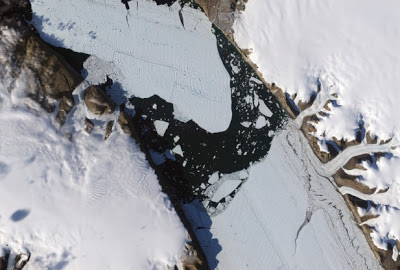
While the impact of climate change on the surface of the Greenland ice sheet has been widely studied, a clear understanding of the key process of iceberg production has eluded researchers for many yearsWhile the impact of climate change on the surface of the Greenland ice sheet has been widely studied, a clear understanding of the key process of iceberg production has eluded researchers for many years. Published in Nature this week, a new study presents a sophisticated computer model that provides a fresh insight into the impact of climate change on the production of icebergs by Greenland glaciers, and reveals that the shape of the ground beneath the ice has a strong effect on its movement.
Over the past decade, ice-loss from the Greenland Ice Sheet has been accelerating, raising concerns about runaway losses and consequent sea-level rise. But research into the four major Greenland fast-flowing glaciers has enabled scientists to show that while these glaciers may show several bursts of retreat and periods of high iceberg formation in future, the rapid acceleration seen in recent years is unlikely to continue unchecked.
This is a crucial step forward in understanding how Greenland’s glaciers will contribute to sea-level rise in the future and indicates, say the scientists, how important a more detailed knowledge of such glaciers is. The scientists first investigated the current behaviour of the four glaciers and found that the rate at which they lose ice depends critically on the shape of the fjords in which they sit, and the topography of the rock below them.
A computer model for fast-flowing outlet glaciers was then specifically designed from their investigations. It gave a projected sea-level-rise contribution from these glaciers of 2cm to 5cm by the year 2200, which is lower than estimates based solely on the extrapolation of current trends.
Lead author Dr Faezeh Nick, of the Université Libre de Bruxelles, says,
“I am excited by the way we have managed to create a detailed picture of the workings of the glaciers. It turns out that if the fjord a glacier sits in is wide or narrow it really affects the way the glacier reacts. The important role of the terrain below the ice shows we need to get a much clearer picture of the rest of Greenland’s glaciers before we have the whole story.”
The scientists chose the four glaciers, Petermann, Kangerdlugssuaq, Helheim and Jakobshavn Isbræ, as together these drain around 20 per cent of the Greenland ice sheet. The model, which was developed within the EU funded ice2sea programme, predicts that, together these glaciers will lose on average, 30Gt of ice per year to 47Gt per year over the 21st century. A Gigaton (Gt) is the equivalent of 1 cubic kilometre (km3) of water. For comparison Lake Geneva contains about 90Gt of water.
Professor David Vaughan, who works at the British Antarctic Survey in Cambridge and is head of the ice2sea programme says,
“We know that the breaking off of icebergs from glaciers is influenced by climate, but this is the first time we’ve been able make projections of how the most important glaciers in Greenland will be affected by future climate change. The ice2sea research led by Dr Nick shows how a truly international programme can make it possible for scientists to work together across different institutions to make significant steps forward.”
Note : This story has been adapted from a news release issued by the British Antarctic Survey










